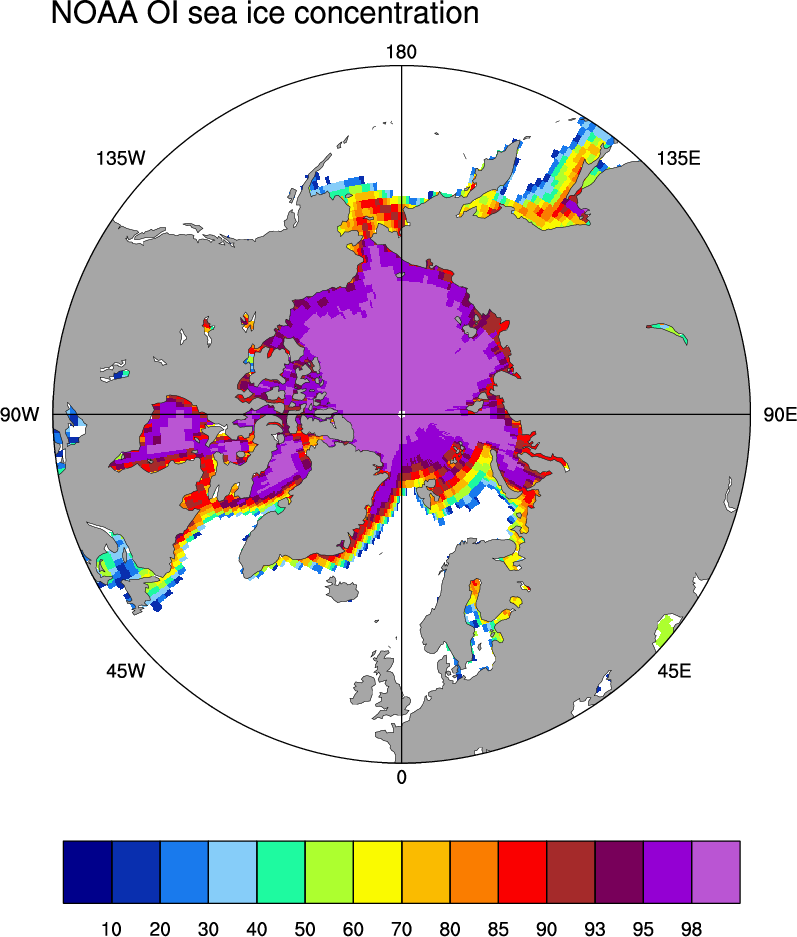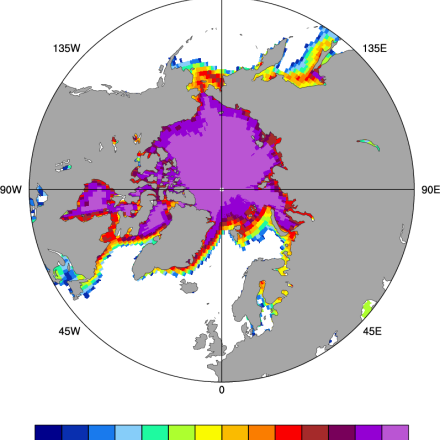Sea Ice Concentration data from NOAA OI

The NOAA Optimal Interpolation (OI) v2 sea ice data set contains gridded, weekly or monthly resolution sea ice concentration estimates for both the Northern and Southern Hemispheres. It is intended as a consistent analyses for input into SST analyses (and is the basis for calculating SSTs in sea ice zones for the OI SST data) or as boundary conditions for atmospheric models. The sea ice portion of NOAA OI v2 is produced similarly to HadISST sea ice, using adjusted passive microwave derived sea ice data from from the NASA Goddard NASA Team algorithm followed by operational sea ice data from NCEP. Users should be aware that the NOAA OI sea ice contains similar discontinuities as HadISST in recent years (see Screen, 2011).
Key Strengths
Gridded, long-term weekly or monthly data set convenient for modeling or analyses
Regularly updated
Key Limitations
Higher resolution and more homogenous (single algorithm) data are available for the modern satellite period, 1979-present.
Similar to HadISST through ~1996; post 1996 no adjustments were made to account for changing satellite sources and/or algorithms employed by NCEP; switches made in 1997, 2004, 2006, 2009 and 2011 may strongly affect the timeseries
from NOAA ESRL: NOAA_OI_SST_V2 data provided by the NOAA/OAR/ESRL PSD, Boulder, Colorado, USA, from their Web site at http://www.esrl.noaa.gov/psd/
Cite this page
Acknowledgement of any material taken from or knowledge gained from this page is appreciated:
National Center for Atmospheric Research Staff (Eds). Last modified "The Climate Data Guide: Sea Ice Concentration data from NOAA OI.” Retrieved from https://climatedataguide.ucar.edu/climate-data/sea-ice-concentration-data-noaa-oi on 2025-04-17.
Citation of datasets is separate and should be done according to the data providers' instructions. If known to us, data citation instructions are given in the Data Access section, above.
Acknowledgement of the Climate Data Guide project is also appreciated:
Schneider, D. P., C. Deser, J. Fasullo, and K. E. Trenberth, 2013: Climate Data Guide Spurs Discovery and Understanding. Eos Trans. AGU, 94, 121–122, https://doi.org/10.1002/2013eo130001
Key Figures
Other Information
adjusted passive microwave -derived sea ice from NASA Goddard and NCEP operations
1° x 1°
